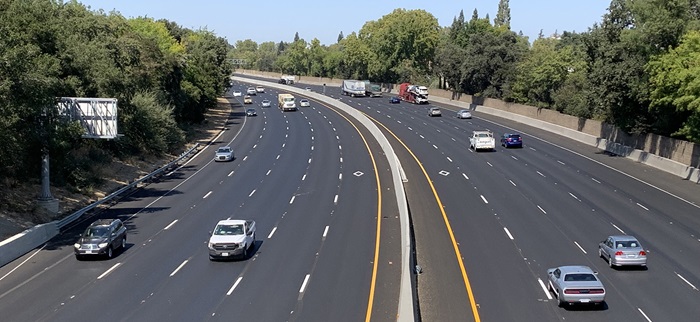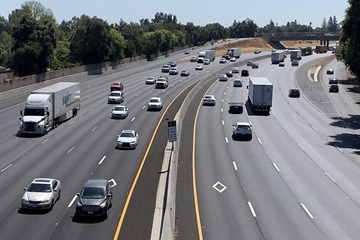Project spotlight: Final-touches time for Sacramento’s ‘FixSac5’

District 3 photograph
Capital commuters, others benefit from $370 million Interstate 5 Corridor Enhancement Project
Anyone who resides in the Sacramento metropolitan area or has driven through it at any point during the past four years likely has encountered the $370 million Interstate 5 (I-5) Corridor Enhancement Project.
Launched in 2019 to rehabilitate pavement, construct new carpool lanes, replace a pedestrian overcrossing, construct sound walls, install new fiber optic lines, add ramp meters and extend various entrance and exit ramps, the “FixSac5” project is nearing completion. (This spring, work still required occasional overnight closures of some ramps and connectors; the latest updates are posted on the FixSac5.com website.)
The smooth pavement alone has made a profoundly positive difference for all motorists on the roughly 15-mile stretch of I-5 from a bit south of Elk Grove Boulevard on up to Discovery Park, where the freeway crosses the American River. All told, the project repairs 67 lane miles and constructs 23 miles of High Occupancy Vehicle (HOV), or carpool lanes.
Beyond the material updates and additions FixSac5 has accomplished, it also seeks to:
- Improve traffic operations by reducing congestion and travel time.
- Provide more reliable peak travel times.
- Provide travel time incentives for commuters to use carpools, van pools or buses in peak travel periods.
- Improve air quality by promoting carpool and vanpool.
By the mid-2010s it was clear that this portion of Interstate 5 needed attention. The pavement had deteriorated to the point where it was blotched with pothole and crack repairs and provided what Caltrans deems to be poor ride quality.

The multiyear project has made a big difference in terms of pavement smoothness, and has added several other features that include carpool lanes.
District 3 photograph
The new HOV lanes were needed because the corridor was experiencing recurring congestion during peak commute periods. Traffic demand during commute periods exceeded the freeway capacity, and the amount and duration of congestion is expected to increase in the future as suburban development in portions of the city of Sacramento and the City of Elk Grove increase.
Three-quarters ($280 million) of the project’s total cost was funded by the State Highway Operation and Protection Program, Senate Bill 1 of 2017, the Road Repair and Accountability Act, provided $48.3 million; the Sacramento Transportation Authority Local Measure A tax contributed $33.2 million; and the Sacramento Area Council of Government's Congestion Management and Air Quality Improvement Program accounted for $8.5 million.
Caltrans’ top priority throughout the four-year construction, of course, has been safety – for both road crews and the motoring public. Work zones have typically been marked by signs, cones, barrels, channeling devices, barriers, pavement markings and/or work vehicles. Lower speed limits were posted and enforced.
During the most work-intensive portions of the project, in the first couple of years, motorists and truckers were strongly encouraged to use State Highway 99 as an alternate route to Interstate 5. Caltrans also has encouraged people to use public transportation, share rides, walk or bike to reach their destinations.
Among the project’s many milestones was when the old pedestrian and bike overcrossing at Casilada Way – between the Sutterville Road and Seamas Avenue exits – was demolished in February 2021 to make way for the new, Americans with Disabilities Act (ADA)-compliant overcrossing. The new Casilada Pedestrian Overcrossing was completed and opened to the public in April 2022.
Some of the project’s many other milestones have included the fortification of a sound wall south of Pocket Road and Meadowview Road; bridge work north of Laguna Boulevard, north of Cosumnes River Boulevard and north of Casilada Way; median widening work at Laguna Boulevard to north of Laguna Boulevard; and asphalt work from Florin Road to the I-5 interchange with U.S. Highway 50, which included 55-hour weekend closures.
One challenge that Caltrans has encountered is the electrical work lagging behind in the project schedule. To help with moving the electrical work forward and resolve issues in a timely manner, a weekly electrical meeting among the contractor, construction office and electrical group is held to discuss schedule, RFIs (requests for information) and any electrical issues.
Additionally, field meetings with both the contractor and electrical group investigating the issues together have provided faster solutions. All parties have the partnering mindset to complete the electrical work within the remaining project schedule.
Another challenge on this project was traffic closure conflicts with other construction projects working in our same area. Initially, conference calls were held with the contractors and District 3 Transportation Management Center to coordinate the closures. Caltrans asked the contractors to coordinate among themselves two weeks ahead of time, which resulted in fewer traffic closure conflicts.
Caltrans has remained within budget for all work proposed on the project. The roadway rehabilitation work is complete, and the HOV lanes are in operation, which officially was open to the public on Oct. 24, 2022. As of Mile Marker publication, Caltrans is fine-tuning some minor construction items to be ready for project acceptance.
Source: Dennis Keaton, District 3 information officer; Erin Mock, assistant resident engineer

